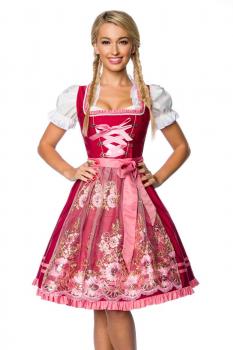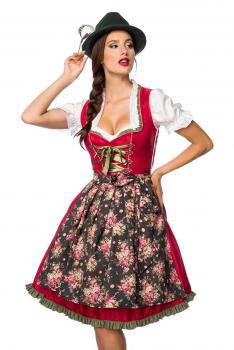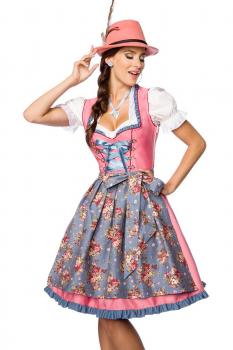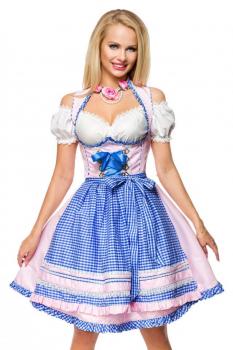Atixo NEWsfeed


May Day!
Customs, traditions and useless knowledge
Wie herrlich leuchtet
mir die Natur!
Wie glänzt die Sonne!
Wie lacht die Flur!
(Johann Wolfgang von Goethe)
Yes, not only Goethe celebrated the merry month of May in his poem Mailied, but also the rest of Germany dedicated some festivities and customs to this special month. When the unstable month of April comes to an end and sunny, green May is just around the corner, this is of course a reason to celebrate. Throughout Germany there are many different traditions and customs. The Maibaum, dances and the May fire are only a part of it. We´ve searched for some information and would like to share our knowledge with you now.
The most famous of all traditions is the Maibaum. As a sign of the recurring spring and as a symbol of fertility, this pagan cult was forbidden in early Christianity and only found its way back to German congregations in the 16th century. This original thought of the Maibaum was lost with the time somewhat and thus today often the competition stands in the center. Set up on the central square of the village, many villages compete every year for the largest Maibaum. By the way, the highest Maibaum has even made it into the Guinnes Book of Records with 57 meters. Through this competition it became a tradition in Bavaria that rival villages try to steal the Maibaum from each other. This Maibaum theft follows strict rules. As a trigger often some barrels of beer are demanded. The favour of the hour is also used by many young men to put a small, decorated Maibaum in front of their loved one's house. Attention ladies: in the leap year the women put the tree. After the placement of the village Maibaum follows a somewhat outdated tradition, the Mailehen. This is the joking auction of the girls.
The dance into May is certainly known to everyone. On the night of 1 May, you can shook a leg at various festivals, balls and celebrations. In Southern Germany, of course, there are traditional costumes dancing around the Maibaum, while in other parts of Germany mayballs, spring parades and beer festivals take place at the start of May.
No matter how the merry month of May is celebrated, of course one thing should not be missing - alcohol! How about a fine Maibowle? This traditional drink was invented in 854 in the Prüm monastery to strengthen the heart and liver. Whether or not it really fulfils this purpose is not clear, but with white wine, mineral water and woodruff it is definitely a delicious and refreshing drink in a warm May night.
Also on this evening the so-called Walpurgis Night is celebrated, which is also called Hexennacht because of its origin. It is dedicated to the holy Walburga and is celebrated especially on the Brocken (mountain in the Harz), where a big fire is ignited. To drive away evil spirits, a large campfire is also set in many other German villages. It should protect the citizenz from the witches, who hold large celebrations on this evening, according to the legend, and play tricks on humans. Thus the tradition developed to play mostly harmless tricks in the neighbourhood.
So there are numerous traditions and festivals that are worth celebrating. We hope we have been able to give you some new insights and you are looking forward to this wonderful month just as we are. It's better to stock up now with the right Dirndl for your May celebration, they are quickly sold out.
mir die Natur!
Wie glänzt die Sonne!
Wie lacht die Flur!
(Johann Wolfgang von Goethe)
Yes, not only Goethe celebrated the merry month of May in his poem Mailied, but also the rest of Germany dedicated some festivities and customs to this special month. When the unstable month of April comes to an end and sunny, green May is just around the corner, this is of course a reason to celebrate. Throughout Germany there are many different traditions and customs. The Maibaum, dances and the May fire are only a part of it. We´ve searched for some information and would like to share our knowledge with you now.
The most famous of all traditions is the Maibaum. As a sign of the recurring spring and as a symbol of fertility, this pagan cult was forbidden in early Christianity and only found its way back to German congregations in the 16th century. This original thought of the Maibaum was lost with the time somewhat and thus today often the competition stands in the center. Set up on the central square of the village, many villages compete every year for the largest Maibaum. By the way, the highest Maibaum has even made it into the Guinnes Book of Records with 57 meters. Through this competition it became a tradition in Bavaria that rival villages try to steal the Maibaum from each other. This Maibaum theft follows strict rules. As a trigger often some barrels of beer are demanded. The favour of the hour is also used by many young men to put a small, decorated Maibaum in front of their loved one's house. Attention ladies: in the leap year the women put the tree. After the placement of the village Maibaum follows a somewhat outdated tradition, the Mailehen. This is the joking auction of the girls.
The dance into May is certainly known to everyone. On the night of 1 May, you can shook a leg at various festivals, balls and celebrations. In Southern Germany, of course, there are traditional costumes dancing around the Maibaum, while in other parts of Germany mayballs, spring parades and beer festivals take place at the start of May.
No matter how the merry month of May is celebrated, of course one thing should not be missing - alcohol! How about a fine Maibowle? This traditional drink was invented in 854 in the Prüm monastery to strengthen the heart and liver. Whether or not it really fulfils this purpose is not clear, but with white wine, mineral water and woodruff it is definitely a delicious and refreshing drink in a warm May night.
Also on this evening the so-called Walpurgis Night is celebrated, which is also called Hexennacht because of its origin. It is dedicated to the holy Walburga and is celebrated especially on the Brocken (mountain in the Harz), where a big fire is ignited. To drive away evil spirits, a large campfire is also set in many other German villages. It should protect the citizenz from the witches, who hold large celebrations on this evening, according to the legend, and play tricks on humans. Thus the tradition developed to play mostly harmless tricks in the neighbourhood.
So there are numerous traditions and festivals that are worth celebrating. We hope we have been able to give you some new insights and you are looking forward to this wonderful month just as we are. It's better to stock up now with the right Dirndl for your May celebration, they are quickly sold out.










